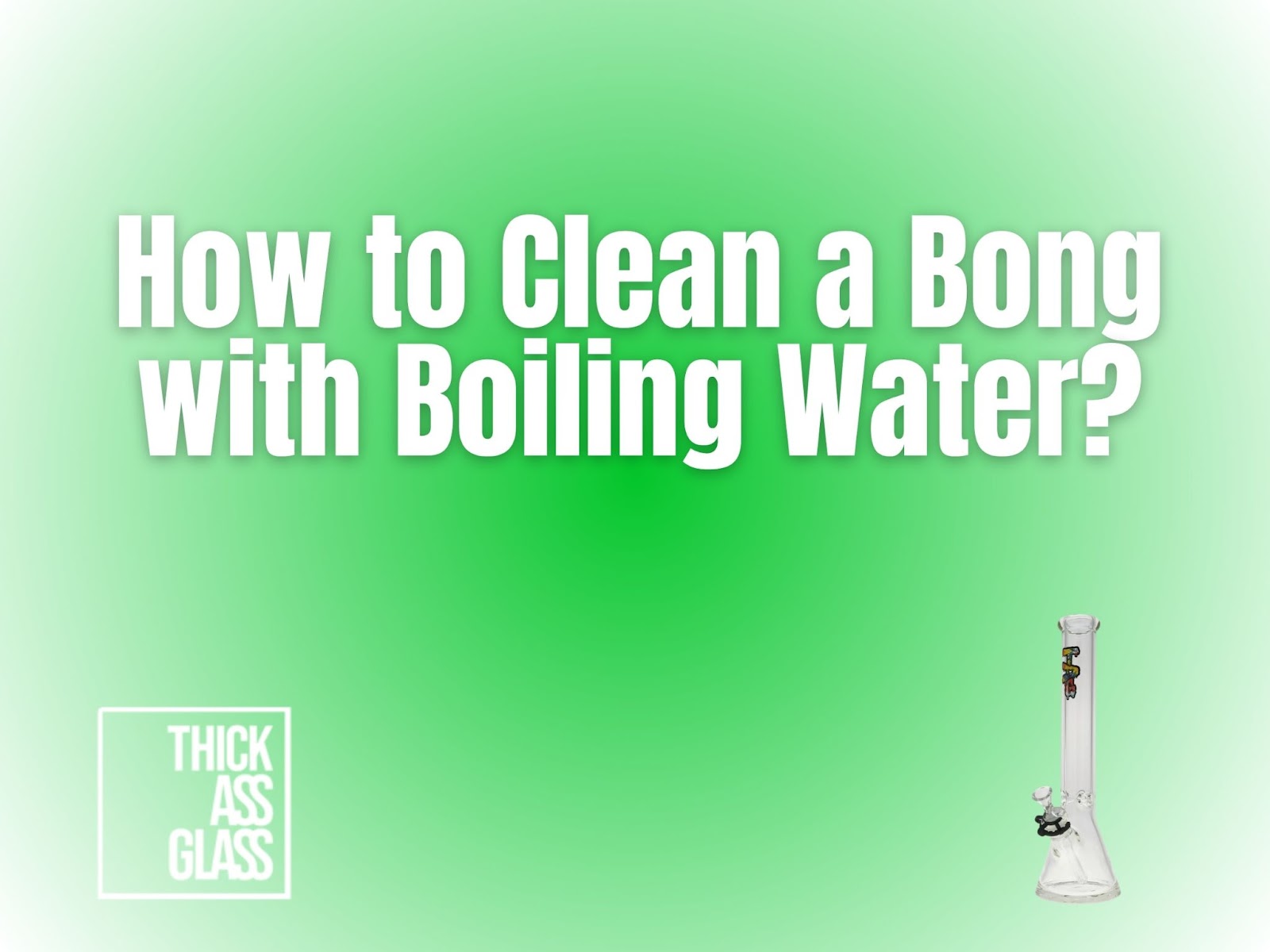To clean a bong with boiling water, disassemble it, place in cold water, heat gradually to boil, add mild detergent or salt, shake carefully, rinse with hot water, and let cool naturally. Avoid sudden temperature changes to prevent thermal shock.
Clean Glass Is Non-Negotiable
Every hit leaves a little behind. Resin clings to glass like it is paying rent, and if you let it pile up your airflow, flavor, and overall experience start heading downhill. That is why regular cleaning is not optional. It is how you keep your piece working like the day you unboxed it.
There are plenty of ways to go about it:
-
Isopropyl alcohol + coarse salt – quick, abrasive, and reliable.
-
Commercial cleaners – ready-made solutions for those who do not want to mix.
-
Boiling water – high heat for loosening the most stubborn resin.
-
Vinegar – dissolves mineral deposits and softens resin without strong chemical odors.
Ever since we launched Thick Ass Glass, we work with heat-resistant, premium borosilicate that can take serious use. Even the thickest glass needs care. My approach has always been to engineer it to work better, last longer, and be worth maintaining.
Whether you are running a simple straight tube or a multi-perc recycler, keeping it clean is the easiest way to protect your investment.
In this guide, we will get into the specifics of cleaning with boiling water, why so many people like it, where it can go wrong, and exactly how to do it without cracking your glass. We will also talk about glass thickness, percolator design, and why certain bongs make the cleaning process less of a chore.
The Enemy Inside: Resin Build-Up on the Glass
Resin starts forming the moment smoke meets water. Tiny particles and sticky tar swirl through the bong, then cling to the glass wherever the flow slows down. Chambers, percolators, and downstems are prime targets because smoke and water cycle through them repeatedly during use.
The resin layer begins soft, so a quick rinse can sometimes remove it. Once it sits for a few sessions, it thickens and grips the glass with stubborn tenacity.

When airflow passes through those coated surfaces, it slows down. Diffusion holes clog, drag increases, and you find yourself working harder for a hit that delivers less. The flavor suffers as well. Instead of clean terpene notes, you get a burnt aftertaste mixed with stale resin vapor.
These changes creep up gradually, which is why some smokers do not realize how much performance they have lost until they clean their piece and taste the difference.
Why Hardened Resin Becomes a Problem
If resin is left for weeks or months, it can cure into a hardened layer that resists alcohol and light scrubbing. At that point, heat or more aggressive agitation becomes necessary to break it loose. Hardened resin can also hide fine cracks or joint wear, allowing them to worsen unnoticed.
The parts most vulnerable to severe buildup include:
-
Honeycomb percs where tiny holes trap particles.
-
Fritted discs with their dense micro-pores.
-
Downstem slits that easily clog and block airflow.
-
Joint welds where resin collects in seams and is harder to reach.
Targeting these areas during cleaning keeps airflow smooth and flavor crisp. Leaving them coated not only affects performance but also makes each future cleaning session longer and more labor-intensive.
Boiling Water Cleaning: Simple and Sometimes Effective
Using boiling water to clean a bong has an appeal that is easy to understand. It is inexpensive, uses no harsh chemicals, and the process is straightforward. For pieces with complex percolators or narrow passages, heat can reach places that brushes and even alcohol have trouble accessing.
When done with patience and control, boiling can strip away buildup that has been locked in place for weeks.
Heat Power: How Boiling Breaks Down Resin
Boiling water works by softening the sticky resin so that it loses its grip on the glass. The constant heat keeps the resin pliable long enough for it to be shaken or rinsed away. This is especially helpful for fine percolators and deep chambers, where resin hides in spots too tight for physical tools to reach.
Honeycomb percs, fritted discs, and other intricate designs benefit from this method because the heat penetrates every passage at the same time. Even if you cannot see the resin breaking away, the improvement in airflow afterward often confirms that the method worked.
Additives: Detergent, Salt, or Nothing?
Some smokers prefer to enhance boiling water cleaning by adding a small amount of mild dish soap. The soap helps break down the oily compounds in resin, allowing it to rinse away more easily. Others opt for coarse salt, which moves through the water during shaking and gently scrubs the glass from the inside.
A tip from seasoned users is to use dishwasher softening salts, which dissolve slowly and act like countless tiny cleaning beads in hard-to-reach spaces. Whichever additive you choose, avoid anything too abrasive or chemically aggressive.
Harsh powders and strong solvents can scratch the surface or leave residues that affect taste during the next session.
The Downsides You Cannot Ignore
Boiling water carries some risks. The biggest concern is thermal shock, where sudden changes in temperature cause glass to crack. This can happen if you place cold glass into boiling water or rinse hot glass under cold tap water.

Over time, repeated boiling may also weaken delicate percolator arms or loosen decorative features bonded to the glass. Residues from soap can remain in hidden spots if you do not rinse thoroughly with hot water afterward, and those residues will alter the taste of your next hit.
Knowing these limitations makes it easier to decide when boiling is the right choice and when another cleaning method would be safer.
Here Is How to Clean Your Bong with Boiling Water
Once you know the benefits of heat cleaning, the next move is learning exactly how to do it so your glass stays safe and your airflow feels brand new. Boiling water cleaning is all about gradual temperature changes, the right tools, and a method that works with the design of your bong instead of against it.
Preparation: Set Yourself Up for Success
Take the bong apart so every surface can be cleaned properly. Remove the downstem, bowl, and any modular parts. Check that the glass is in great condition for heat cleaning. Warming it briefly under hot tap water helps it adjust naturally to the temperature rise.
Have your setup ready before you start. A large pot gives enough room for your piece without contact on the sides. Oven mitts help with safe handling. Silicone cleaning caps keep water and additives inside during shaking.
Choose either mild detergent or coarse salt, and have a soft towel and silicone mat nearby and ready for the drying and cooling stage
Step-by-Step Instructions
This process keeps the temperature change gradual, uses the heat to soften resin, and lets your chosen additive handle the rest. Follow these steps in order so the glass stays protected while buildup is completely removed.
-
Place the bong into the pot with cold water.
-
Heat the water gradually until it reaches a steady boil.
-
Add your choice of mild detergent or coarse salt.
-
With oven mitts on, gently shake to help free resin.
-
Let the piece soak for 10 to 15 minutes.
-
Lift it out and rinse thoroughly with hot water.
-
Set it on a silicone mat and let it air-cool to room temperature.
Choosing a Bong That’s Easy to Clean
A bong that is easy to maintain keeps every session tasting fresh and every draw feeling smooth.
Cleaning becomes much simpler when the glass is built to handle heat and the design gives you access to every surface where resin can settle. With the right piece, you spend less time rinsing and more time enjoying your setup.
Glass Thickness: Your First Line of Defense
Thick glass handles temperature changes from hot cleaning far better than thin glass. It is common for our bongs to have borosilicate walls that measure up to 9 mm thick, with bases between 12 and 16 mm.
This level of thickness distributes heat more evenly and supports the glass during repeated boiling water cleans. The added weight also keeps the bong stable when you are shaking out water during cleaning.
Percolators: Smooth Draws With a Practical Twist
Percolators can make every hit cooler and smoother, but the extra chambers and slits also collect resin more quickly. Designs like honeycomb and fritted percs respond especially well to boiling water because heat can loosen resin from their many small openings.
Once the buildup softens, a thorough rinse clears the pathways so airflow returns to normal. Careful handling during the process ensures the fine glasswork inside stays intact.
Here are three TAG models that combine great performance with straightforward cleaning:
-
TAG 18" Beaker Bong 50×9 MM – A solid base and wide chamber allow for quick rinsing and easy access during deep cleans.
-
TAG 16" Straight Tube Bong 50×9 MM – A clean, minimal design with no complex percolators makes for faster upkeep and smooth draws.
-
TAG 9" Modular Showerhead Donut Rig – Modular construction lets you separate each part for targeted cleaning and full rinsing.
Boil Your Bong Often to Keep It Pulling Perfectly
A well-maintained bong always rewards you. Clear glass moves air the way it was engineered to, flavor comes through without interference, and every session feels as smooth as the first.
Boiling water is one of those straightforward techniques that works beautifully when paired with thick, well-designed glass. The right piece handles the heat, cleans quickly, and is ready for use again with minimal downtime.
For bongs that meet that standard, explore the Thick Ass Glass bong collection and find the piece that will keep delivering clean, satisfying hits for years.



